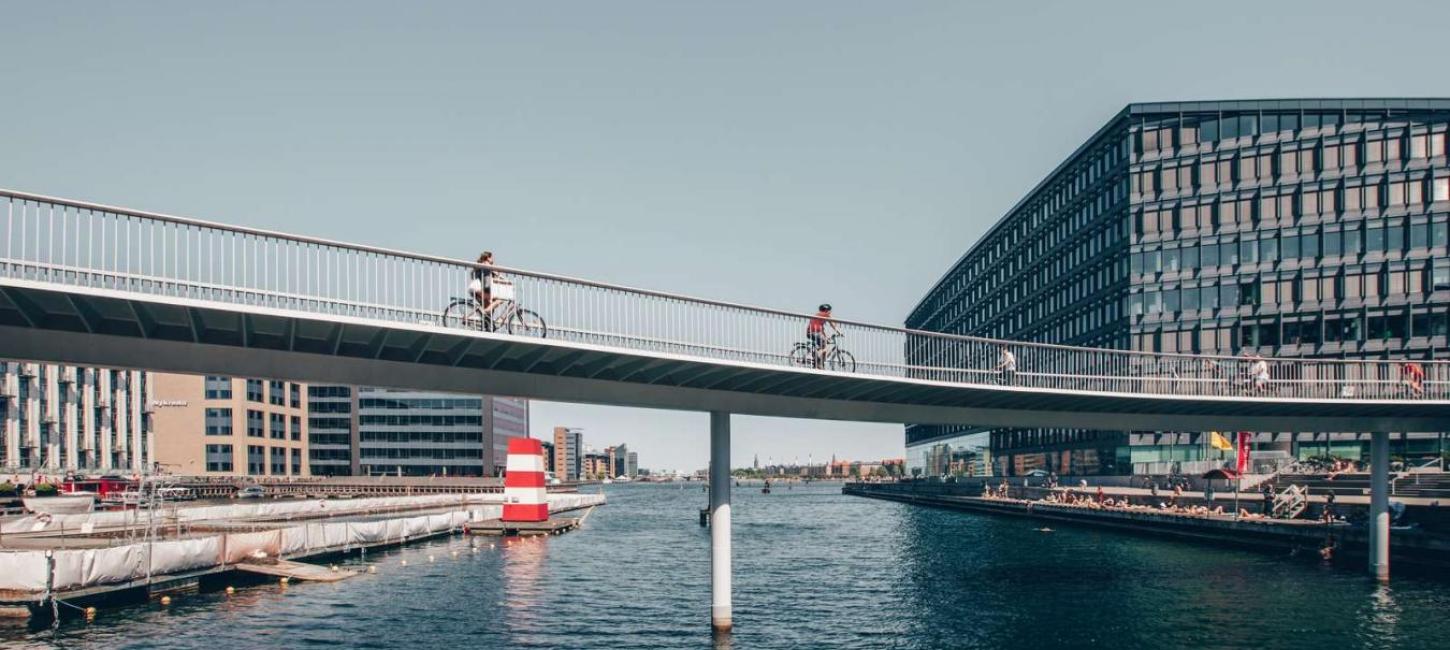What makes Copenhagen the world’s most bicycle friendly capital?
By James Thoem, Copenhagenize
This article was published in April 2020.
Copenhagen ranks as the world's best capital city for cycling and locals take pride in getting around on their two-wheeler. But is it something in our culture, is it in our DNA or is it maybe something quite different that makes half the Copenhageners chose the bike for their daily commute?
The morning rush hour along Copenhagen’s Dronning Louises Bro is in many ways just like any other. A crowd of tired, blank faces yawning their way to work. There is of course a healthy dose of nordic-chic outfits, but otherwise there is little to no eye contact and scant conversation. Indeed, a rush hour like any other.
The remarkable difference here is that these under-caffeinated commuters are getting to work by bike, joining a city-wide chorus of hundreds of thousands of Copenhageners that rely on the simple bicycle as their vehicle of choice.
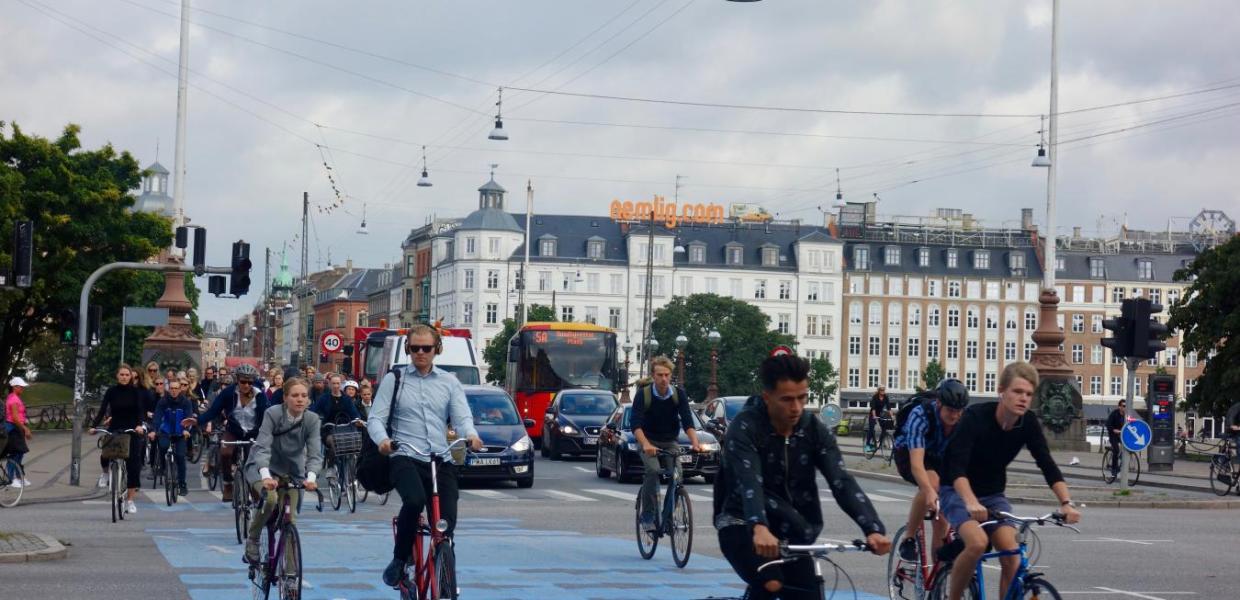
On any given workday more than 40,000 people cycle across Queen Louises BridgePhoto:Copenhagenize
For those who are counting, Copenhageners cycle an estimated 1.44 million kilometres daily. 49% of all trips to work or school in Copenhagen are by bike, up from 35% just ten years ago. This recent rise in cycling over the past decade is a result of continued municipal investment. The City has pledged investments equalling more than €40 per capita in bicycle infrastructure investments. While this figure pales in comparison to public transport and private automobile infrastructure, it shows that cycling is taken seriously. And something seems to be working, 97% of Copenhageners are satisfied with the cycling conditions in the city. Of those that do cycle, three quarters continue to do so through the long, dark, nasty Danish winters.
But what is it about Copenhageners that makes them take to the bicycle every morning come rain, sleet, or snow? Is the average Copenhagener more eco-conscious than you? Hardly. Is it because they’re all a bunch of health freaks? Not a chance. Or maybe because the bicycle is just part of the Danish DNA? Nope. It comes down to three important factors: Infrastructure, infrastructure, and infrastructure. Copenhagen has demonstrated that with a network of simple, safe, and connected infrastructure, the bicycle can be a competitive mode of transportation for people of all ages and abilities.
Simple Infrastructure
Danish design is renowned for its focus on simplicity and function. Whether you’re talking dining room chairs, apartment buildings, or motorway bridges, Danish design at its best understands and accommodates the user and context. The same goes for bicycle infrastructure. Cycle through Copenhagen (and beyond) and you’ll notice that no matter the context, cycling is rather easy in its simplicity. Simpler yet, cycling infrastructure appears in four basic typologies: traffic calmed streets, painted bike lanes, separated cycle tracks, and green routes get you where you need to go. All without requiring a user manual.
On quieter, more residential streets, cycling is accommodated in a more subtle way. Rather than reserving a dedicated lane separating bicycle riders from cars, the two modes share the roadway. This, however, hinges on the requirement that cars drive no faster than 30 kilometres per hour, better yet, 20. To simply rely on signage stating the speed limit is naïve. To ensure that car drivers actually drive at a safe speed, you’ll notice how residential streets in Copenhagen have been treated with a variety of traffic calming measures. By narrowing lane widths, tightening corner radii, and using textured surfaces, motorists drive slowly, by design. It is only then, that car drivers and bicycle riders of all ages and abilities can ‘share the lane’ comfortably.
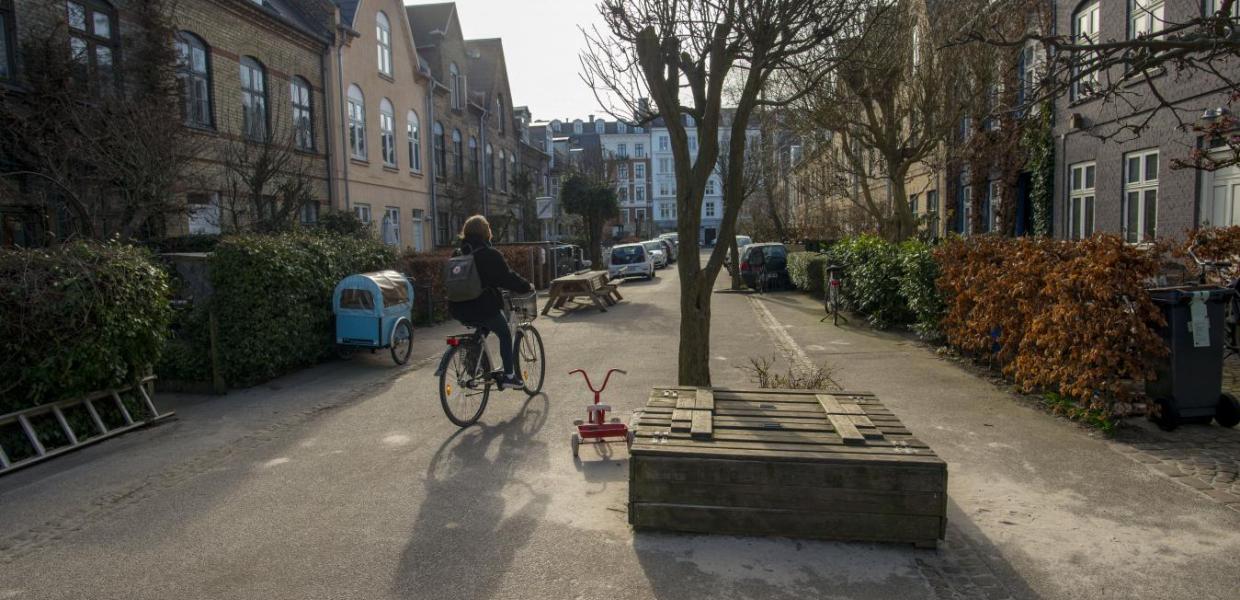
Narrowed lanes and planter boxes calm traffic by design.Photo:Copenhagenize
Along busier neighbourhoods streets, you’ll notice bike lanes separated by a simple painted line. In certain situations, the painted bike lane can be an effective way to provide bicycle riders a dedicated space. You’ll notice that cars are expected to park in between the bike lane and car traffic, adding an extra level of protection between bicycle riders and cars. This, of course, relies on the motorists to obey the painted line, something that can’t always be counted on. For that, and many other reasons, the curb separated cycle track is more effective.
The cornerstone of this network is the curb separated cycle track. Separated from both car traffic and pedestrians with a simple curb, the cycle track provides all street users a simple and intuitive experience. A quick glance at a typical main street in Copenhagen, and each user knows exactly where they belong. Pedestrians on the sidewalk, bikes on the cycle track, and cars and busses on the roadway. You’ll also notice the symmetry of the street, with a one-way cycle track on either side of the street. No confusing weaving of bike lanes from roadway to sidewalk only to disappear for two blocks before reappearing again in a completely different form. Just straight and simple cycle tracks.
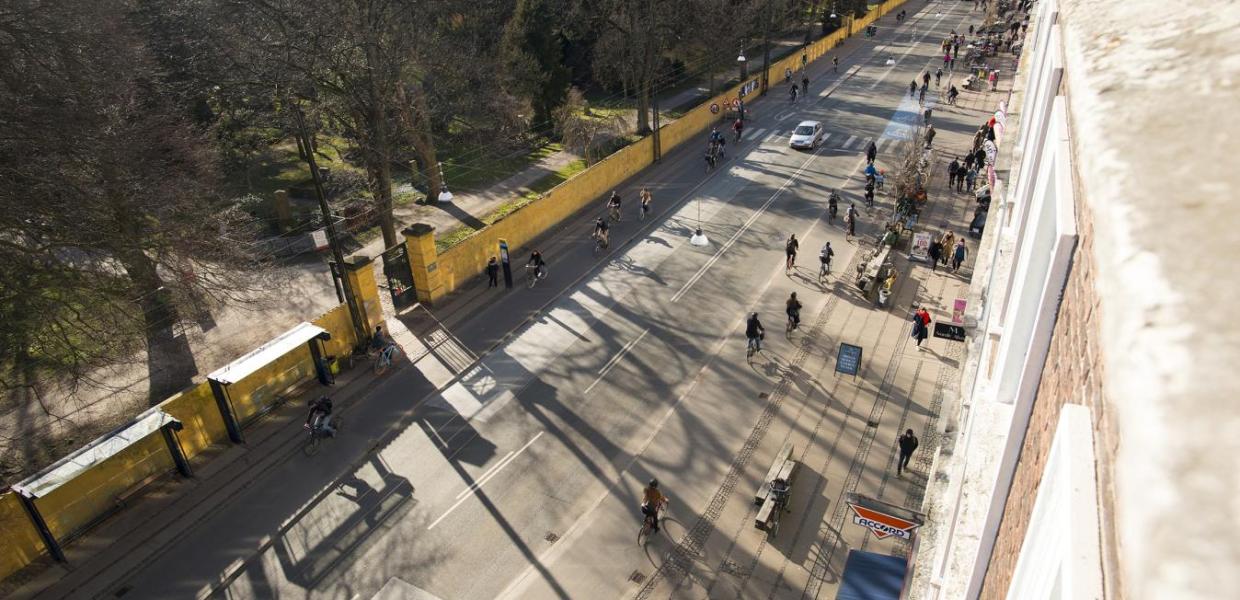
Along Nørrebrogade wide cycle tracks accommodate tens of thousands of cyclists every day.Photo:Copenhagenize
Along busier, more trafficked streets outside of the city centre, the curb separation is strengthened by an extra gap between the cycle track and cars provides for a safer experience. These buffered cycle tracks go a step further in making sure the bicycle riders feel safe as they travel along the more uncomfortable streets.
And finally, the fourth typology of bicycle infrastructure you’ll see in Copenhagen is the off-street path. Running through parks or along waterfronts, railway lines, and highways, these off street paths provide recreational routes and help stitch together the network of on street bike lanes. The design of these off street greenways still maintains a separation between pedestrians and bicycle riders through different surface colours. Some, like the harbour ring, are better suited for recreational riders. While others, like the regionals ever expanding cycle highways, provide long stretches of comfortable and uninterrupted routes for commuters.
By sticking to these four simple typologies, everyday cycling in Copenhagen quickly becomes something that is intuitive and reliable. No need to readjust your riding style with each corridor, just simple cycling. Whatsmore, these simple typologies make cycling safer by design.
Safe Infrastructure
People of all ages cycle in Copenhagen not only because it’s safe, but because it feels safe. An average of 5.7 million kilometres are cycled between each serious accident. Last year, of the millions of cycle trips, there were 81 seriously injured cyclists reported, a number that has decreased by one third in the past decade. At the same time, perception of safety has improved as well. Polls show that more than three quarters of residents feel safe when cycling.
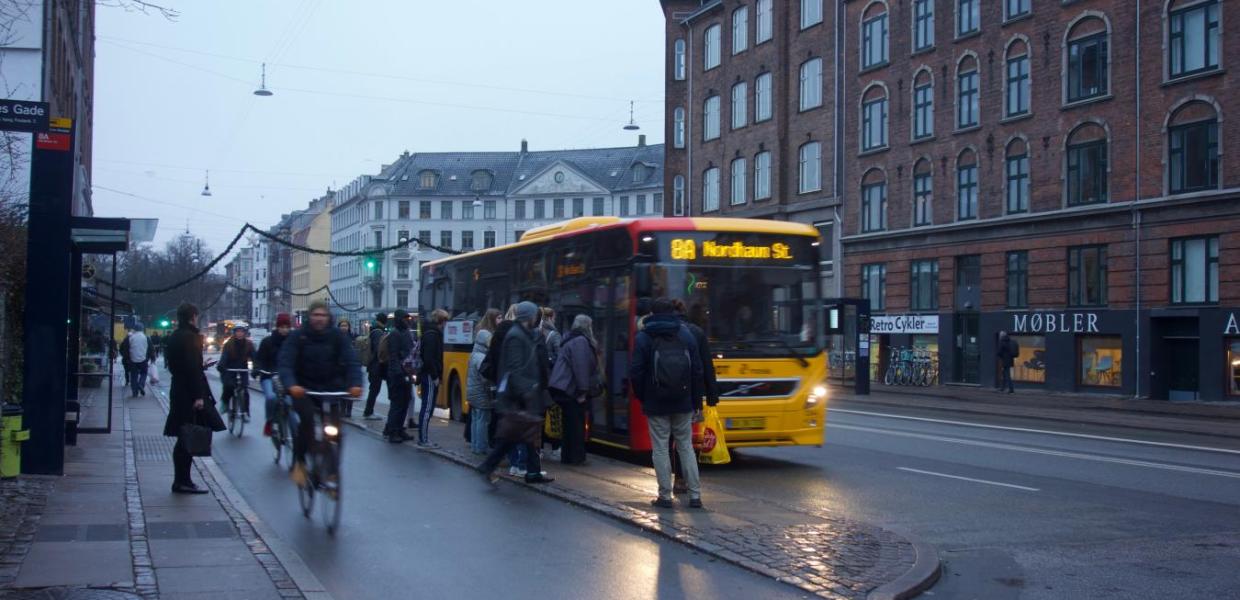
With a simple island, both bus passengers and cyclists can safely navigate an otherwise tricky situation.Photo:Copenhagenize
Perception of safety is a fragile thing. If for just one block or one intersection it dips down, that may be the difference from someone choosing to leave the bike at home. To avoid this, streets in all neighbourhoods and all contexts must feel safe while cycling. The four typologies addressed above go a long way in ensuring safety. But look to the intersections to see how design can make cycling safer. Intersections small and large are vulnerable places for cyclists, as they come to a cross with faster, heavier vehicles.
Walk or cycle along one of the city’s high streets, and you may notice that the crossings at intersecting quieter residential streets are different. Or you may not notice, and that’s the point. In these cases, intersections are designed to prioritize the more vulnerable road users, pedestrians and cyclists, over cars and trucks. By continuing sidewalks and cycle tracks at a consistent level, the design requires cars to slow down before entering the intersection, rather than having pedestrians look both ways, yield, and step down into the street at every block. And in doing so these intersections act almost as a line of defence for residential neighbourhoods, forcing cars to slow.
At busier intersections a different set of design details make cycling safer. One of the most dangerous situations is the so-called right hook, where right turning cars, and especially trucks, collide with bicycle riders in their blind spot. A couple of features can help reduce these. You may notice that at many intersections, bicycle riders, like cars and pedestrians, have their own dedicated traffic signals shining red, yellow (or amber, for those traffic nerds), and green. While the bicycle signals generally run in sync with the others, they are often afforded a couple seconds head start before the cars. This simple detail gets bicycle riders into the intersection first and out of the blind spots of cars and trucks. To further protect bicycle riders from a right-hook collision, many busier intersections feature a set back stop-line for cars. The set back stop-line design has bicycle riders stopped a full five metres ahead of car drivers. And just as with the advance green signal, this design puts cyclists ahead, out of the blind spot of cars.
And one additional detail seen at busier intersections is the bicycle railing. This simple piece of street furniture is a clever way of both showing bicycle riders that they are appreciated while also making for more predictable interactions. With these railings placed at red lights, one can stay sitting comfortably on their bike seat while waiting for the signal to change. And once green, the railing serves as a starting block, allowing bicycle riders to push off with a boost of momentum. But it’s about more than just treating the users, there’s a valuable behavioural aspect of these railings too. The logic goes that when sitting comfortably at a red signal, a cyclist is less likely to become impatient and run a red light. And being positioned at the front of the queue, it’s even less likely that those behind them will opt to break the rules in front of someone patiently waiting. In doing so, the bicycle railings brilliantly treats the bicycle riders while making simultaneously intersections more predictable.
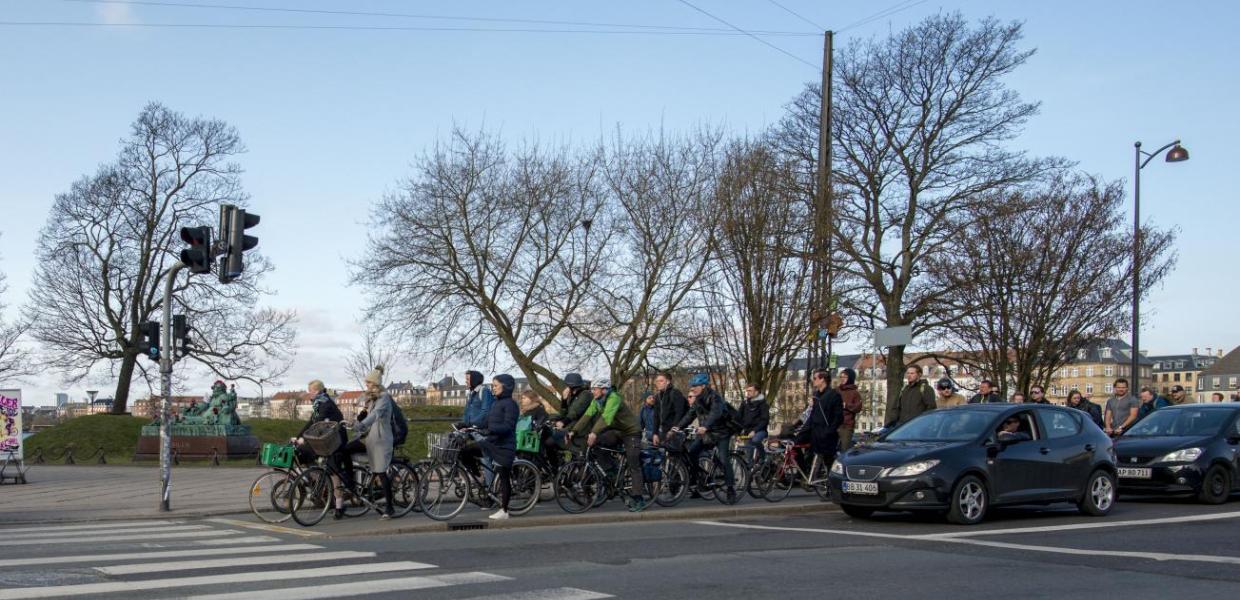
A combination of set back stop-lines, dedicated bicycle signals, and bicycle railings help improve the safety of intersections.Photo:Copenhagenize
With continued investment over the past decades, Copenhagen has started to witness somewhat of a virtuous cycle. With safer infrastructure come more bicycle riders. And with more bicycle riders comes a safety in numbers effect associated increased awareness and visibility throughout the city. The simple and safe infrastructure is a great start, but to really tie the city together, cycling infrastructure must be connected.
Connected Infrastructure
Picture a city with four individual metro lines, each with only two stops, and all completely detached from one another. That would be pretty impractical. Any successful metro network must be connected, providing access to all corners of the city. The same goes for cycling infrastructure.
Connecting bicycle lanes along the existing street grid is one thing, but to further stitch the city together, larger gaps must be bridged. And as a city bisected by a harbour and smaller canals, there has been plenty of bridging to be done. Take the Quay Bridge (Bryggebroen) connecting Havneholmen to Islands Brygge for example. Completed in 2006, Bryggebroen was the first of many new connections built over the Copenhagen harbour in centuries. When first proposed, experts estimated 3,300 daily bicycle crossings over the bridge. But within months of opening more than 9,000 were counted crossing, of which one third were former car drivers. In other words, the existence of this strategically placed bridge has actually created cycling trips. And the latest numbers from 2018 show that with the adjoining Bicycle Snake (Cykelslangen), more than 20,000 cycle across the bridge daily.
Following the success of Bryggebroen, Copenhagen has seen something of a bridge building spree, building more than a dozen dedicated pedestrian and cyclist bridges. The views afforded from many of these bridges are something worth catching. Swooping down the Bicycle Snake (Cykelslangen), the bicycle rider is teased with a brief glimpse up the harbour. And from Olafur Eliasson’s spectacular Circle Bridge (Cirkelbroen) you can appreciate the National Library’s Black Diamond expansion in its intended glory, with glimmers of light bouncing off the facade. But it’s not all about the view. Other less glamorous bicycle crossings over motorways and railways are a reminder of the role of these crossings, to better connect the city for everyday commuters.
Conclusion
Return to Dronning Louises Bridge for the afternoon rush hour. You’ll witness a scene quite different from the morning. A scene nicely demonstrating one of the benefits of investing in simple, safe and connected cycling infrastructure. It’s not just cycling for cycling’s sake. It’s about making a healthy, sustainable, city where people, young and old, enjoy being out and about.
The tens of thousands of commuters that passed during the morning rush hour are now passing back. Only now the mood has completely changed. Some are cycling two abreast, chatting and laughing as they go. Others are slowly chugging along on their cargo bike with their kids up front. And along the sidewalk, people line the bridge, enjoying the late afternoon sun, having a drink, and just watching the evening pass by. Indeed, a rush hour unlike any other.
Five Spots to Witness Best Practice Bicycle Infrastructure
- The Bicycle Snake (Cykelslangen) - Cycle from Vesterbro down the bicycle snake. Sit alongside the harbour and watch the never-ending stream of traffic crossing the harbour.
- Sønder Boulevard - Grab a pizza and a drink to go and find a spot to enjoy it along the linear park on Sønder Boulevard. Here the roadway has been narrowed, reducing car speeds and making for a more welcoming green space.
- Nørreport Station - Walk through the public square at Nørreport station and you’ll notice an innovative bike parking solution where the racks sit on lowered platforms. This simple trick gives a more open vista of the square.
- Dronning Louises Bro - Grab an early coffee and pastry and watch the morning rush hour at 08:30. Better yet, enjoy a drink with a friend in the sun in the late afternoon.
- The Cycle Highway to Bagsværd - Follow the new regional cycle highway (Supercykelstier) route towards Farum. Hop off the highway at Bagsværd and visit architect Jørn Utzon’s church.
